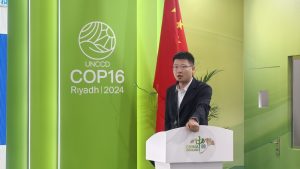[International Energy Network Live Report] The 16th Session of the Conference of the Parties to the United Nations Convention to Combat Desertification (UNCCD) (COP16) “Off-grid Solar Energy Empowers Land and People in Desert Areas” side event was held at the “China Pavilion” in Riyadh, Saudi Arabia on the morning of December 9th .
Gao Sheng, General Manager of Zhejiang Gaoming New Material Technology Co. Ltd, delivered a speech on the topic of “Solar green house help the development of agriculture in desertified area”.

Gao Sheng, General Manager of Zhejiang Gaoming New Material Technology Co. Ltd
Gao Sheng introduced the control of desertification by CdTe sunrooms, APV is the best way, and focuses on desert roses.
CdTe sunrooms are the best way to solve desertification
Gao Sheng said that Photovoltaic module panels shade direct sunlight, effectively reducing the evaporation of surface water; The shading effect of photovoltaic panels can reduce evaporation by 20 to 30 percent, and photovoltaic module panels can also effectively reduce wind speed. This is a great way to improve the living environment of plants. The appearance of surface vegetation in turn contributes to the sand fixation and water retention of the surface, and the improvement of ecology is also beneficial to solar power generation. It can be seen that the new ecological environment generated by the photovoltaic module panels from direct sunlight has a positive effect on desertification control and produces a win-win result.. Therefore, CdTe sun room is the best way to solve desertification.
Why APV is the best way to solve the problem, Gao Ming pointed out that the Agricultural photovoltaic (APV) systems reduce evaporation rates, retain soil moisture, and improve water use efficiency through solar module shading, especially in arid regions. At the same time, the integration of solar modules creates a protective microclimate that mitigates crop exposure to extreme weather. However, the positioning and placement of photovoltaic modules has a significant impact on the light exposure of the underlying crops, and the translucent photovoltaic module (STPV) technology is a potential solution to provide optimal plant growth conditions through technologies such as tunable light transmittance.
By testing the growth of six vegetables, jalapenos, bell peppers, lettuce, zucchini, Tasmanian chocolate tomatoes and red racing tomatoes, the researchers concluded: “By optimizing agricultural photovoltaic arrays using translucent cadmium telluride photovoltaic modules, agricultural yields can be increased while maintaining the additional protection of the electrified canopy in traditional agricultural photovoltaic systems.”
Therefore, Through the application of green building materials in the sun room, on the basis of ensuring the function and aesthetics of the building, it can also achieve multiple goals such as energy conservation and emission reduction, improving energy self-sufficiency, improving economic benefits, improving architectural aesthetics and promoting technological innovation.
Desert Rose We Have a Better Solution
Desert roses are widely used in interior decoration and gardening because of their unique morphology and drought tolerance. With the improvement of people’s awareness of green living and environmental protection, the market demand is increasing. Governments around the world will increase investment in green plants and ecological protection to promote the sustainable development of the desert rose industry.
Gaoming Group focuses on the research and development and application of building photovoltaic integration, and continues to move forward to create a world-leading renewable energy building solution provider. In recent years, we have continuously improved our solutions and enhanced our own strength.
The perennial temperature of the photovoltaic sunroom is maintained at 25-30 °C, and the humidity can be controlled at 30%-50%, which is highly consistent with the most suitable growth temperature of 20-30 °C and the humidity of 30%-40%, and the research shows that the yield of desert roses planted in the photovoltaic sunroom can be increased by 20%-30% compared with that planted in the conventional environment. CdTe photovoltaic greenhouse can be used to plant desert rose in desert areas, which can ensure the function of buildings, and can also achieve multiple goals such as energy conservation and emission reduction, improve energy self-sufficiency rate, improve economic benefits, improve architectural beauty and promote technological innovation.
Gaoming Green Energy actively participates in global desertification control with its outstanding technical strength and innovative achievements in the field of building photovoltaics, and is committed to providing customers with safer, more efficient and greener services. In the future, Gaoming will continue to work with global partners to jointly promote the widespread application of green energy technology around the world and help the transformation of global desertification control.






